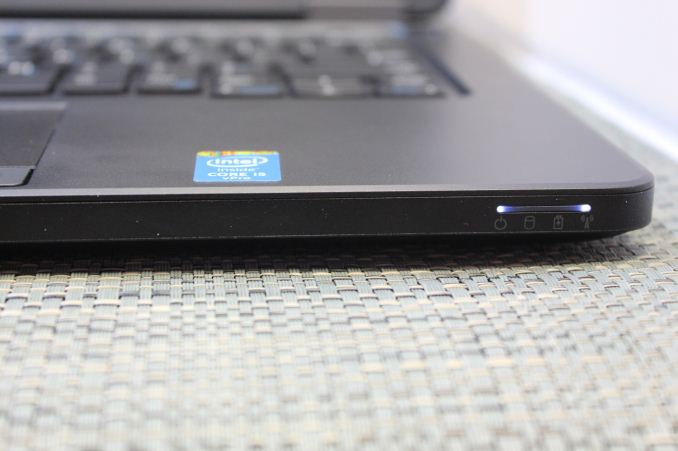Dell Latitude 12 5000 Series Review
by Brett Howse on January 19, 2015 10:30 AM ESTConclusion
While the Latitude 12 5000 series retains a discreet aesthetic, it does check certain boxes for a business laptop. It is available with a Smart Card reader, fingerprint scanner, FIPS certified TPM, optional encrypted drives (OPAL and FIPS), crypto accelerator, Intel V-Pro, and has a solid build quality. Add in a docking port, and a 1 Gbps Ethernet port, and this is a positive laptop for around the office.
On the road, the Latitude E5250 has a good keyboard compared to others, and the trackpad is also a highlight. Battery life is at the top of our charts and should only improve with the new Broadwell based versions that are shipping as of this month due to the decreased audio DSP power draw and SoC efficiency of Gen8 graphics.
The display is, I think, a good compromise, at least as far as pixel density. It does not have the ultra high DPI of something like the Yoga 3 Pro, but the 1920x1080 resolution makes it usable at 100% scaling. Although many consumer applications have now been adapted for high DPI displays, you can bet that many business applications will not be so fortunate, so I think it is important not to get too extreme on the resolution. The 176 PPI strikes a nice balance and the IPS display has great viewing angles and contrast. Accuracy leaves something to be desired, and it would be nice if the display could at least cover the sRGB gamut even if it is not going to be used by imaging professionals.
I had no issues with performance during my time with the device, especially in CPU bound tasks. That coupled with the battery life, and smaller size, makes this a good laptop for on the go. It is a bit heavy, at 3.44 lbs (1.56 kg) with the 3-cell battery, and a bit more with the 51 Wh 4-cell version that was reviewed. With the optional integrated 4G/LTE modem, this would be a good device for on the road (other than the weight). With prices from $830 to over $1500, there is quite a wide range of options to let you fit the device into almost any budget, although from a purely technical perspective, a dual channel memory configuration should be the first upgrade on the list. It would be interesting to see what part of our benchmark suite adjusts based on dual channel performance.
The 5000 series is Dell’s midrange lineup, and it has been fairly impressive. Solid, ergonomic, good display, and great battery life. Dell has crafted a business laptop that should keep any office worker productive, and mobile.












48 Comments
View All Comments
DanNeely - Monday, January 19, 2015 - link
Poking around on Dell's website, it appears that the pointy stick is only offered on 14" or larger models; and the only Latitude line to still offer full power mobile CPUs is the 6000 series. Since the latter are all still last years 6x40 models, it's possible that only reflects their not having been refreshed yet instead of a deliberate decision to keep a more powerful CPU (and optional dGPU) available for business customers outside of the Precision line.nerd1 - Monday, January 19, 2015 - link
Ulv processors nowadays have very high base clock so theres no real need for full voltage one. Mbp 13 also uses ulv cpu.DanNeely - Monday, January 19, 2015 - link
Intel's 37-57W Quadcore Haswell i7's have base frequencies about 1ghz higher (2.2-3.1ghz) than the 17W dual models (1.5-2.1). For anyone who's doing work (compiling medium+ code bases, cad, engineering modeling, etc) that's compute bound not human speed bound; the higher clock rates, extra cores, gpu compute, etc all make a huge difference. The current generation of 2 core ULV laptops are all downgrades from the ~2-3 year old laptop I'm using at worknerd1 - Tuesday, January 20, 2015 - link
It's 2015 now, and broadwell i5-5200U has 2.2-2.7Ghz clock speed.nerd1 - Tuesday, January 20, 2015 - link
If you are really doing computation bound work why do you even bother with 12" business laptops?You can always get clevo P751ZM with 4Ghz Devil's canyon desktop GPU at almost the same price nowadays.
drgigolo - Tuesday, January 20, 2015 - link
But MBP13 uses 28W TPD parts, not 15W. Which gives room for higher performance, especially on the GPU (even more so when running single channel).nerd1 - Tuesday, January 20, 2015 - link
I have compared MBP 13 base model to XPS 13 i5-5200U model and rMBP had only 5% advantage for computation and 9% advantage for GPU. Of course this will change with rMBP update though.BMNify - Monday, January 19, 2015 - link
1.56kb => 1.56kg on the conclusion page , Dell Latitude 14 7000 series is almost perfect laptop in ultrabook business lineup. Hope you review it.cwolf78 - Monday, January 19, 2015 - link
Agree fully on this. The company I work for is going to the E7440's as their default laptop. We used the E6400, E6410, E6420, then E6430 before going to these. A dramatic leap forward in every aspect except performance (compared to the E6420/30). But the increased battery life, quite operation, and lighter weight are a good trade-off. The E7440 does have all around decent performance, but does tend to bog down with a lot of stuff open (especially CPU intensive tabs in Chrome). We're using the i5-4310U, 8 GB of RAM, 256 GB SSD, and 14" 1080p IPS multi-touch screen.Samus - Monday, January 19, 2015 - link
I appriciate the review simply as a reminder why Dell is increasingly irrelevent. When you consider an HP Probook 430 can be had for $300 in Celeron configuration with better build quality (aluminum/magnesium chassis, thinner, lighter.) Dell's charging Elitebook prices for this thing. HP and Lenovo are just killing it while Dell is still making laptops styled from the 90's.